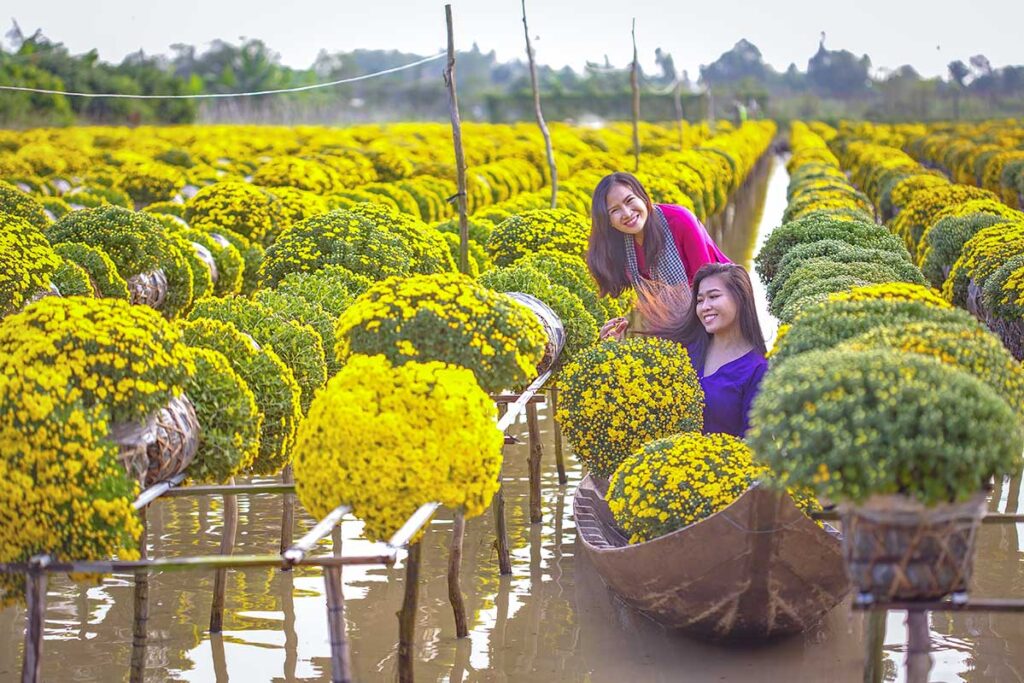What is Sa Dec Flower Village?
Location & Setting
Sa Dec Flower Village is located in Tan Quy Dong Commune, about 3 km from the center of Sa Dec City in Dong Thap Province. The village sits along the Tien River, one of the two main branches of the Mekong. Thanks to the fertile alluvial soil, year-round sunshine, and a mild climate, the area is ideal for floriculture. That natural setting is one of the reasons Sa Dec became the flower capital of the Mekong Delta.
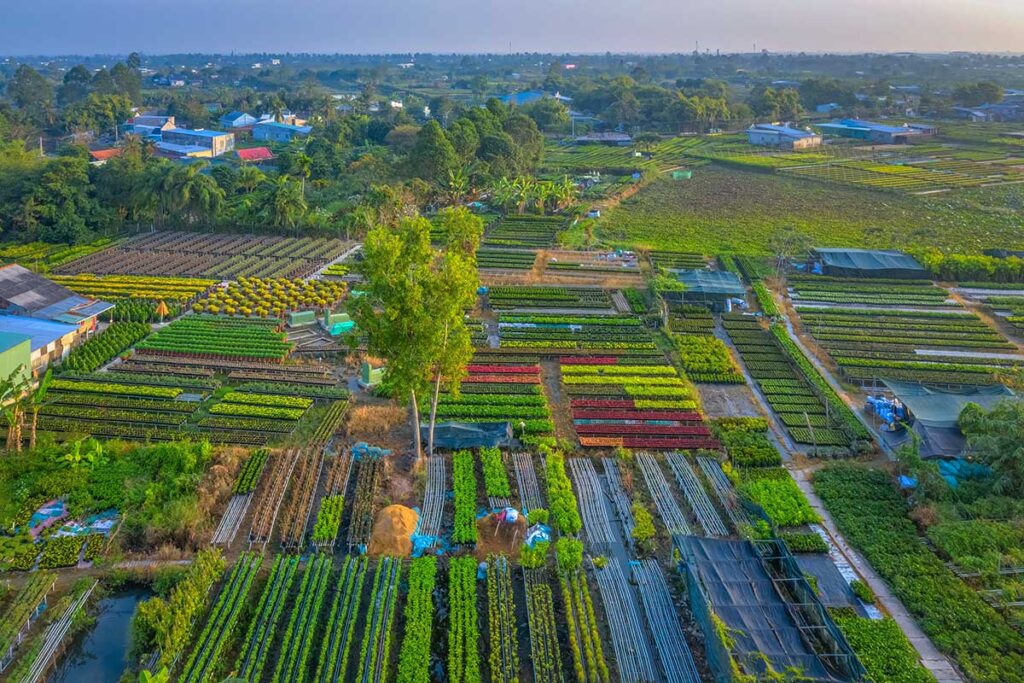
History & Development
Flower cultivation in Sa Dec started in the early 20th century, when only a handful of families grew flowers for Tet (Vietnamese Lunar New Year). Over time, more households switched from rice farming to flower growing, realizing the land’s potential. Today, the village has around 2,000–3,000 households and covers 400–500 hectares of cultivation. It has grown into one of Vietnam’s largest flower suppliers, distributing across the country and even exporting to nearby countries like Cambodia, Laos, and China.
Flower Cultivation & Uniqueness
One of the most unusual things about Sa Dec is the way flowers are grown. Instead of in dry fields, plants are placed on raised wooden or bamboo shelves above shallow water. Farmers wade through the water in boots or paddle small boats to tend to them. This technique developed because much of the land was once low-lying rice paddies, prone to flooding. It makes the village visually distinctive compared to other flower-growing areas in Vietnam.
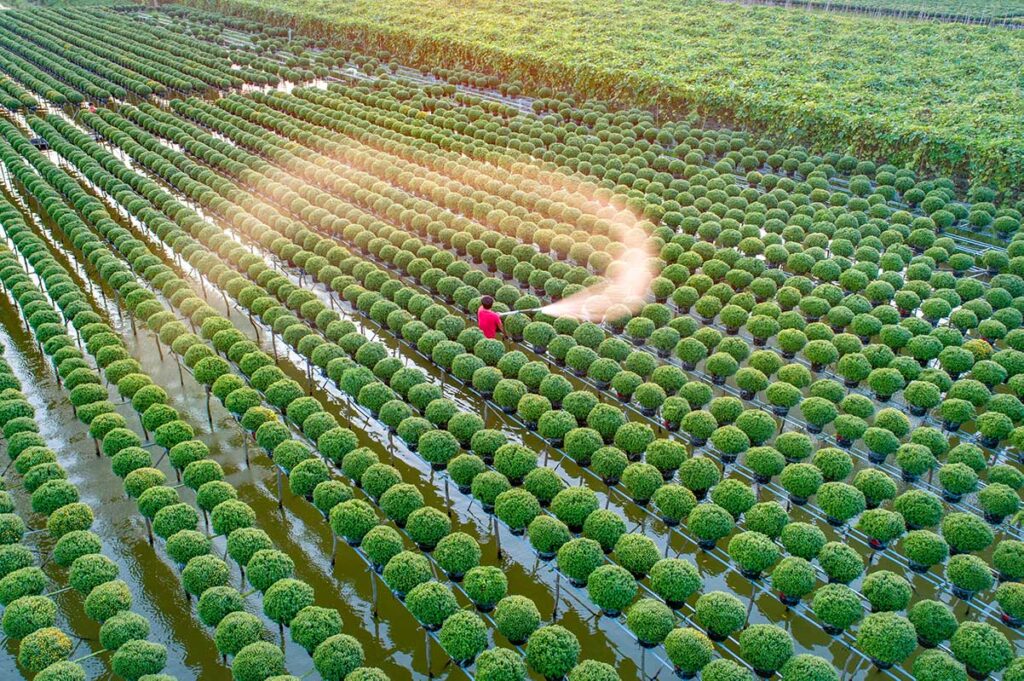
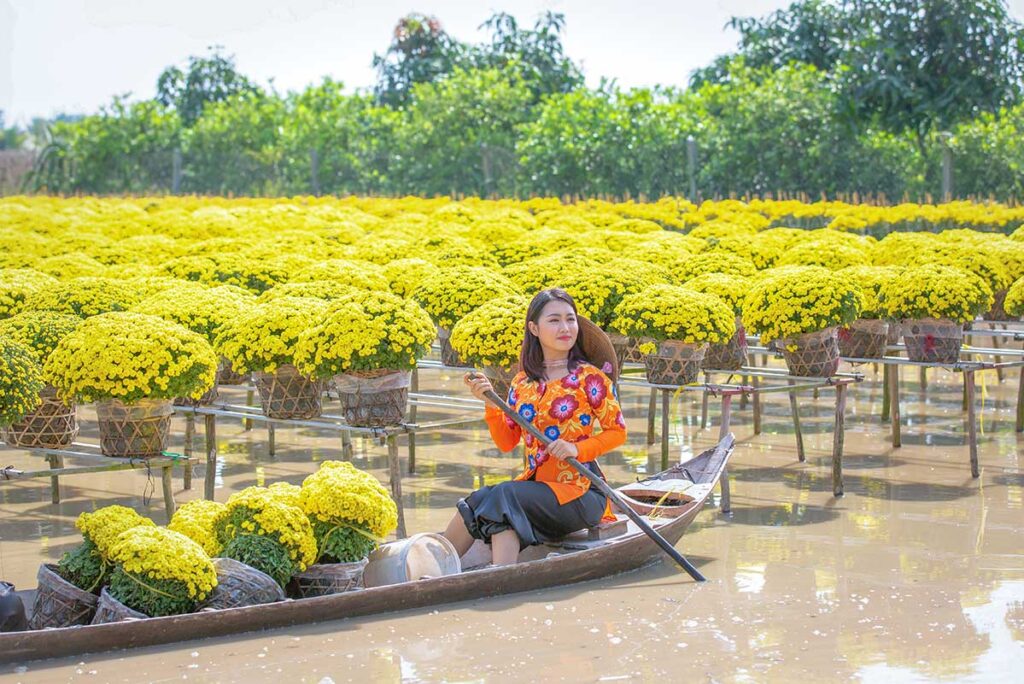
The variety is also impressive: around hundreds of species, including over 50 types of roses, chrysanthemums, orchids, marigolds, hydrangeas, and many tropical ornamental trees. On top of that, Sa Dec is known for bonsai and century-old ornamental trees, shaped by skilled horticulturalists into unique designs.
Cultural & Economic Role
Flowers from Sa Dec play an important role in Tet celebrations across Vietnam. Millions of pots are sent out every year, from small home decorations to large ornamental plants for temples, public squares, and city flower streets. Beyond Tet, Sa Dec continues to produce flowers year-round for domestic use and export.
For locals, floriculture is more than just business — it is a traditional craft village that has become part of their cultural identity. In recent decades, Sa Dec has also embraced tourism: households opening up flower gardens, cafes, and homestays for visitors. While it remains first and foremost a place of production, the village now balances its dual role as both a supplier and a destination.
Best time to visit Sa Dec Flower Village
When it comes to Sa Dec Flower Village, timing is everything. This is not a place where the experience looks the same year-round. Sometimes the village bursts with color and life, other times it feels quieter and more like an agricultural community at work. Knowing when to go is key to deciding whether your visit will be a highlight of your Mekong Delta trip or just a short stop along the way.
Tet and flower season
The most famous time to visit Sa Dec Flower Village is in the weeks leading up to Tet, the Vietnamese Lunar New Year. Tet usually falls between late January and early February, and flowers are central to the celebrations: families decorate their homes, businesses, and temples with fresh blossoms to welcome good fortune.
In Sa Dec, this period is peak season. The village bursts into color as millions of flower pots are displayed, traded, and prepared for transport across Vietnam. About three to four weeks before Tet, the streets and gardens are at their most vibrant, with locals and tourists alike crowding the lanes for shopping and photography. If your timing is flexible, this is when the village truly lives up to its reputation as the flower capital of the Mekong Delta.
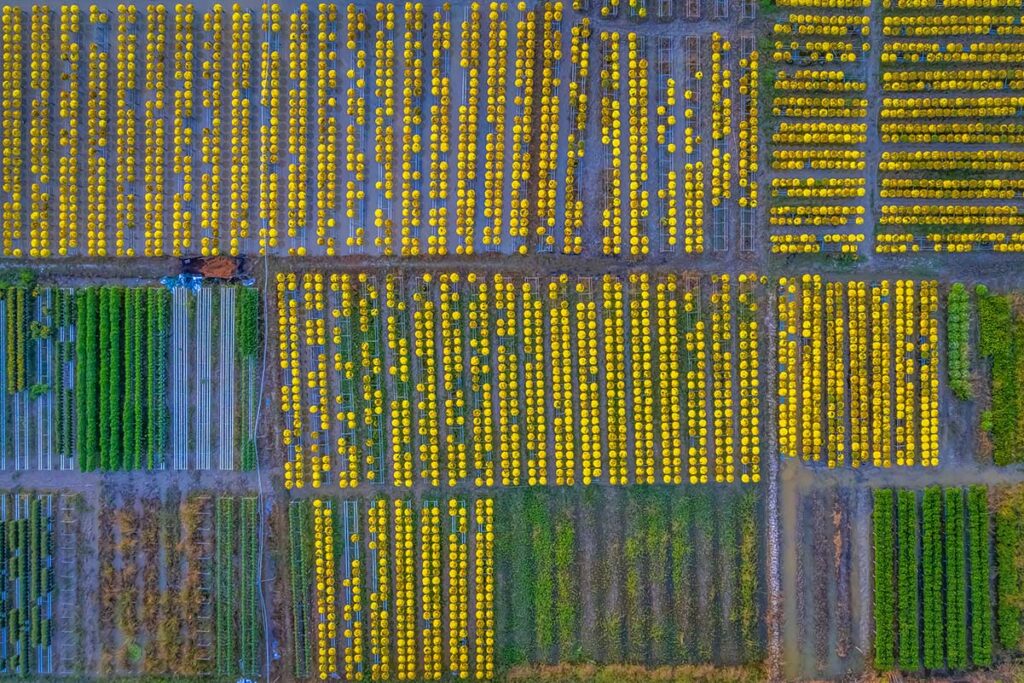
Visiting during other months
Although Tet is the highlight, Sa Dec is not a seasonal-only village. Flowers are grown year-round, since it is both a commercial hub and a traditional craft village. You will still find gardens of roses, orchids, bonsai, and ornamental trees, though not in the same overwhelming abundance as before Tet.
Visiting in the off-season can mean a quieter, less crowded experience. You won’t see the same spectacle of mass displays, but you can still get a sense of local life, admire the cultivation methods, and enjoy cafes and homestays built into the flower gardens.
Honest expectations by season
- Before Tet (December–January): This is the best time. Expect the village to be lively, colorful, and crowded, with excellent photo opportunities. It’s also when most organized tours make a stop here.
- After Tet (March–April): Many flowers are harvested and shipped away. What remains is mostly greenery, so the visit can feel underwhelming if you expect endless blossoms.
- Rest of the year (May–November): Still worth visiting if you are in Dong Thap or nearby, as cultivation continues and you can see roses, bonsai, and daily farming life. However, don’t expect the dramatic displays that flood social media around Tet.
Highlights of visiting Sa Dec Flower Village
The highlights of Sa Dec aren’t theme-park style attractions — they’re the daily scenes of cultivation, transport, and the scale of floriculture. If you come expecting a flower “park,” you may be disappointed. But if you want to see how an entire community makes its living from flowers, you’ll find plenty of rewarding moments.
1. Flower Nurseries & Water Gardens
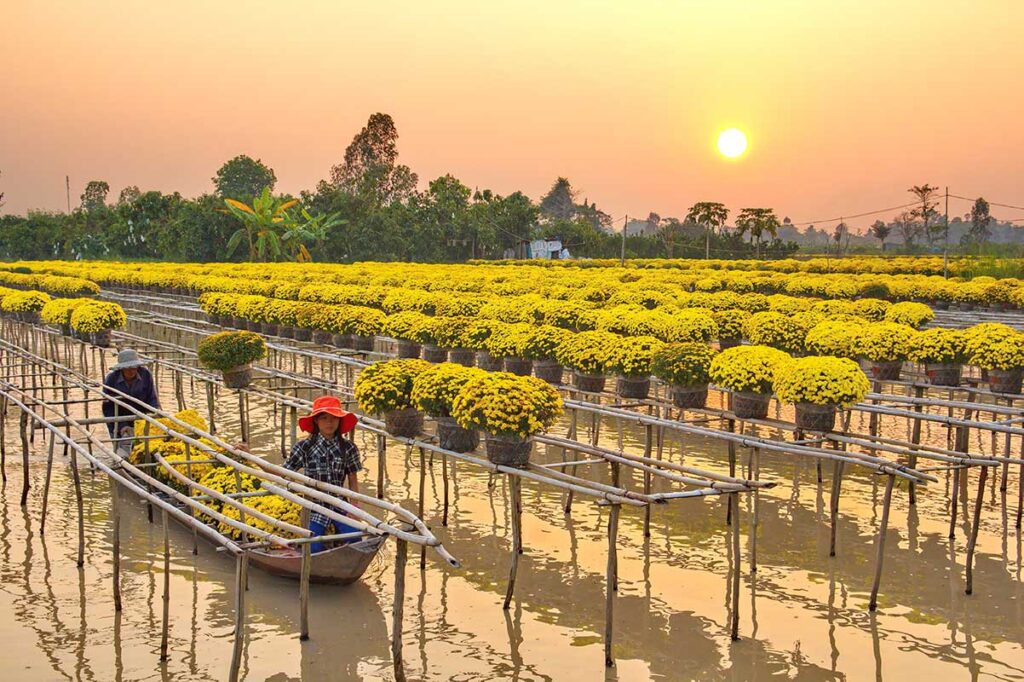
This is the heart of Sa Dec. Thousands of flowers are grown on raised shelves above flooded plots, meaning farmers wade through the water or use small sampans to care for them.
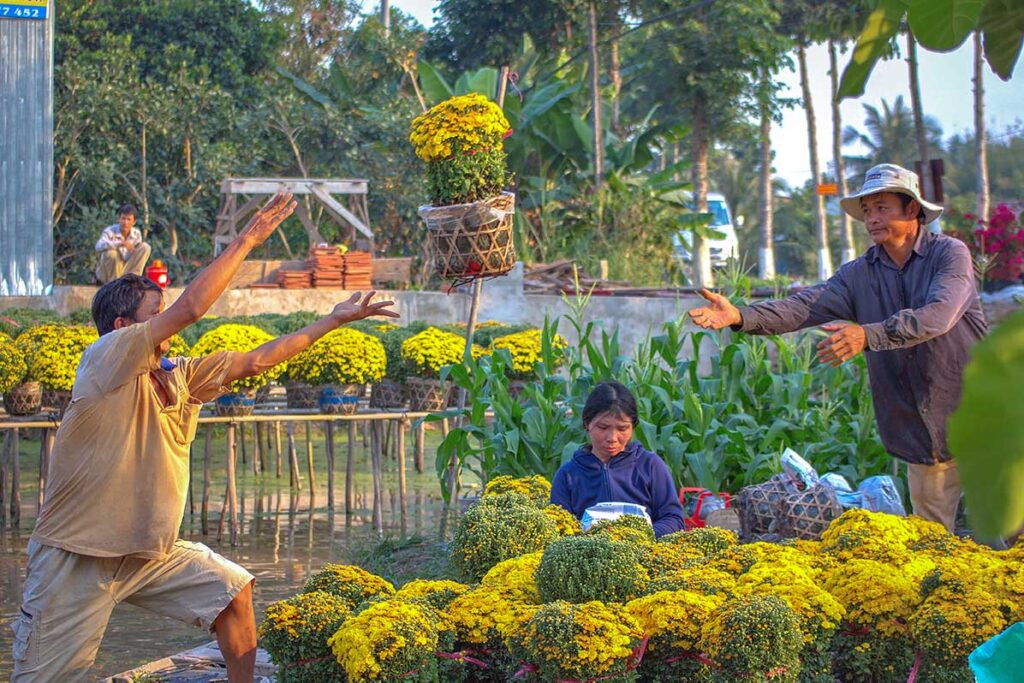
Walking or boating among these nurseries is the most authentic experience: you see rows of chrysanthemums, marigolds, and roses stretching out over the water, with farmers busy watering, trimming, and harvesting. For many visitors, this is the image they came for.
2. River Transport & Market Life
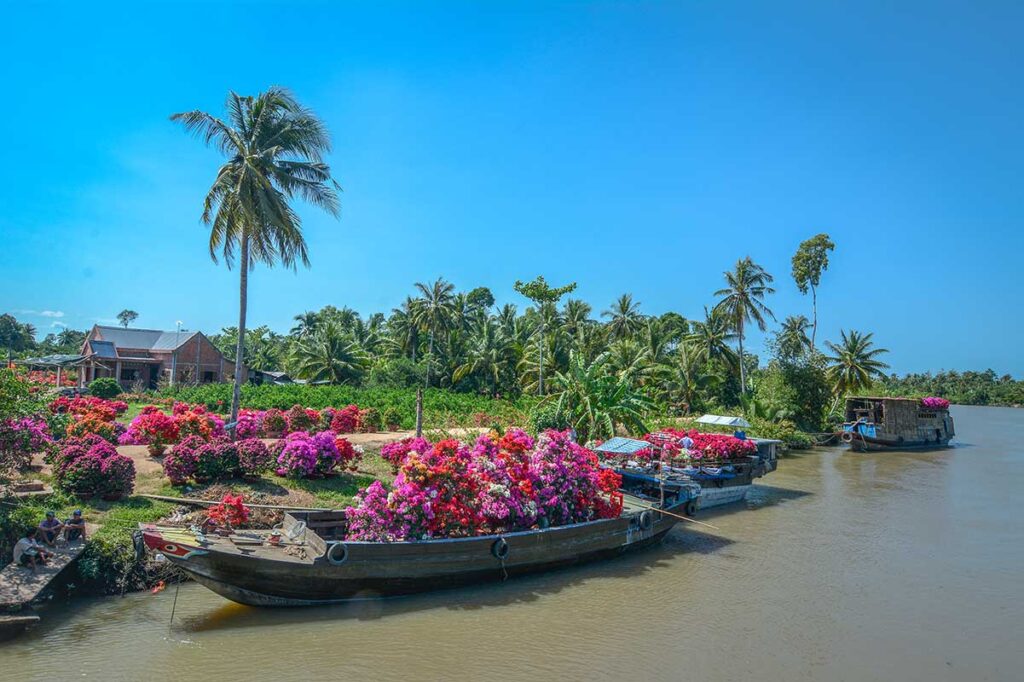
As Tet approaches, flowers are not only sold locally but also shipped to Ho Chi Minh City and beyond. Larger boats are loaded at the riverbank, creating scenes that feel like a mix between an agricultural market and a floating flower festival. Even outside Tet, you may still see boats carrying flowers, though on a smaller scale. It’s a reminder that this is first and foremost a working community, not just a tourist stop.
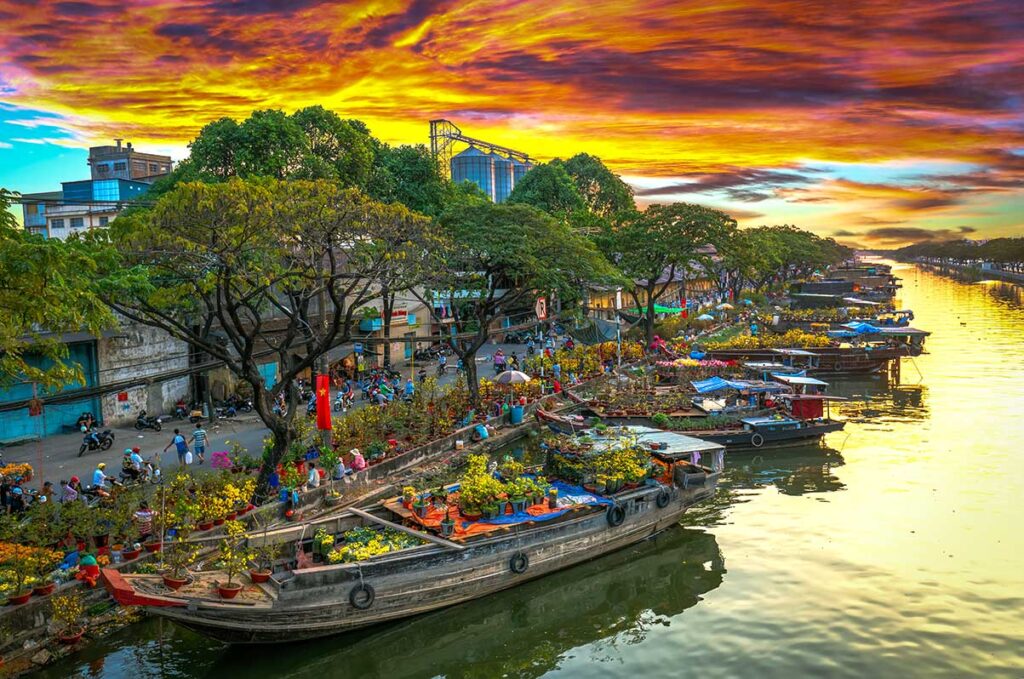
Tip: Many of the boats you see loaded in Sa Dec eventually arrive in Ho Chi Minh City, where they dock at Binh Dong Floating Flower Market in District 8. In the weeks before Lunar New Year, this canal-side market becomes one of the city’s most unique traditions, with flowers sold directly from boats. You can read more in our dedicated guide to Binh Dong Floating Flower Market.
3. Sa Nhien – Cai Dao Flower Street
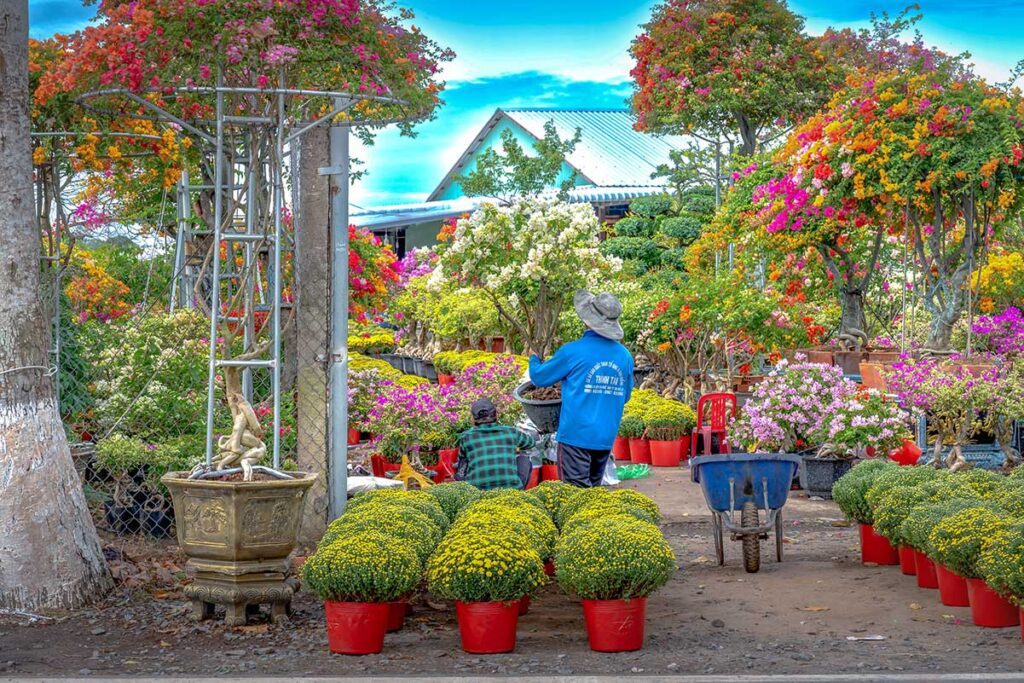
The main flower street stretches 2–3 km with gardens on both sides. During Tet, it turns into a showpiece with decorations, arches, and even LED lights at night. At other times, it’s less dramatic but still a pleasant area to walk or cycle, giving you a sense of the village’s scale.
4. Panoramic Watchtower
There is a small 18-meter watchtower that provides a view over the fields. Some travelers enjoy it, but don’t expect sweeping “mountain view” panoramas — it’s more about getting perspective on the patchwork of flower gardens. It’s useful if you want a bird’s-eye photo, but not an essential stop.
5. Homestays, Cafes & Check-in Spots
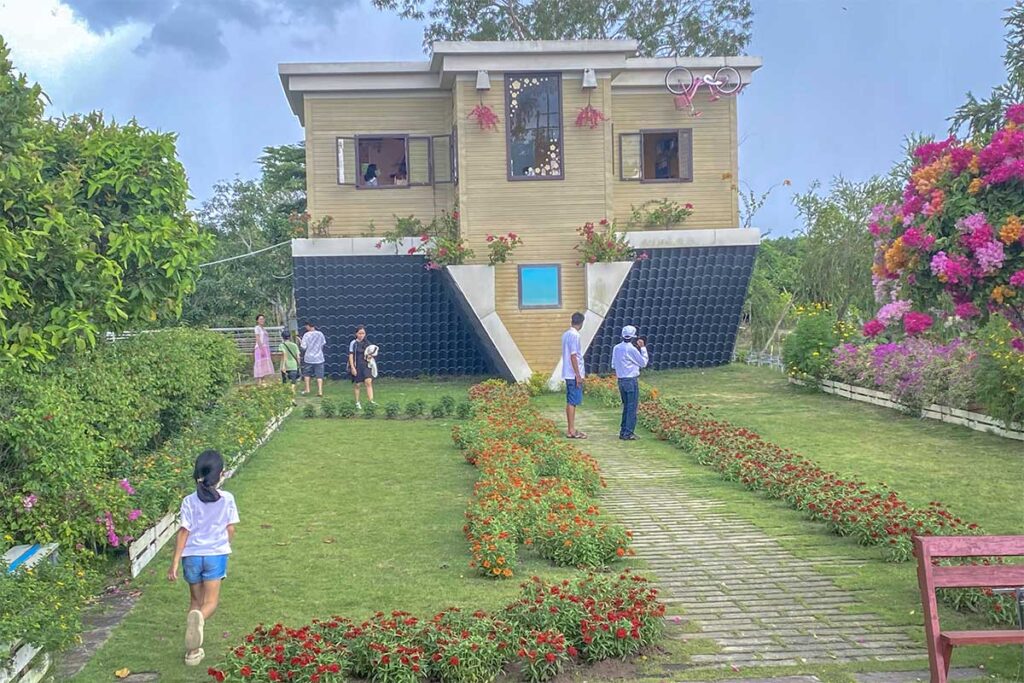
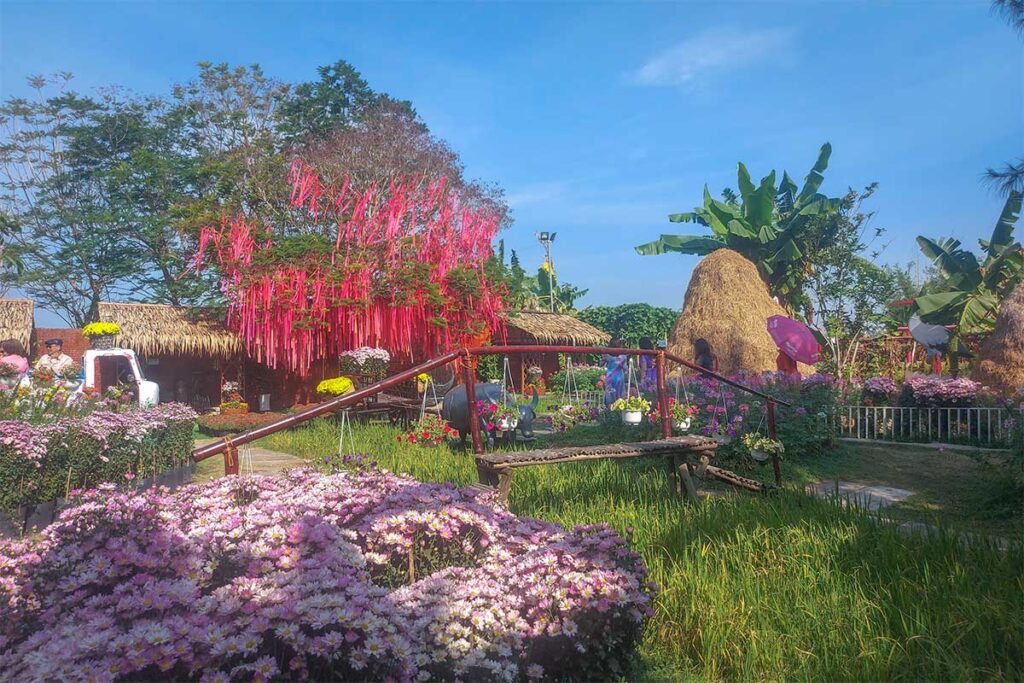
In recent years, locals have set up cafes, homestays, and small tourist complexes inside their gardens. Many are aimed at domestic visitors who enjoy “check-in” photo spots, sometimes with quirky setups like an upside-down house or staged flower displays. These places can feel a bit commercial, but they’re part of the current reality of Sa Dec. If you also enjoy staged photos or want to relax with a drink among the flowers, they can be worth a stop.
6. Bonsai & Ornamental Trees
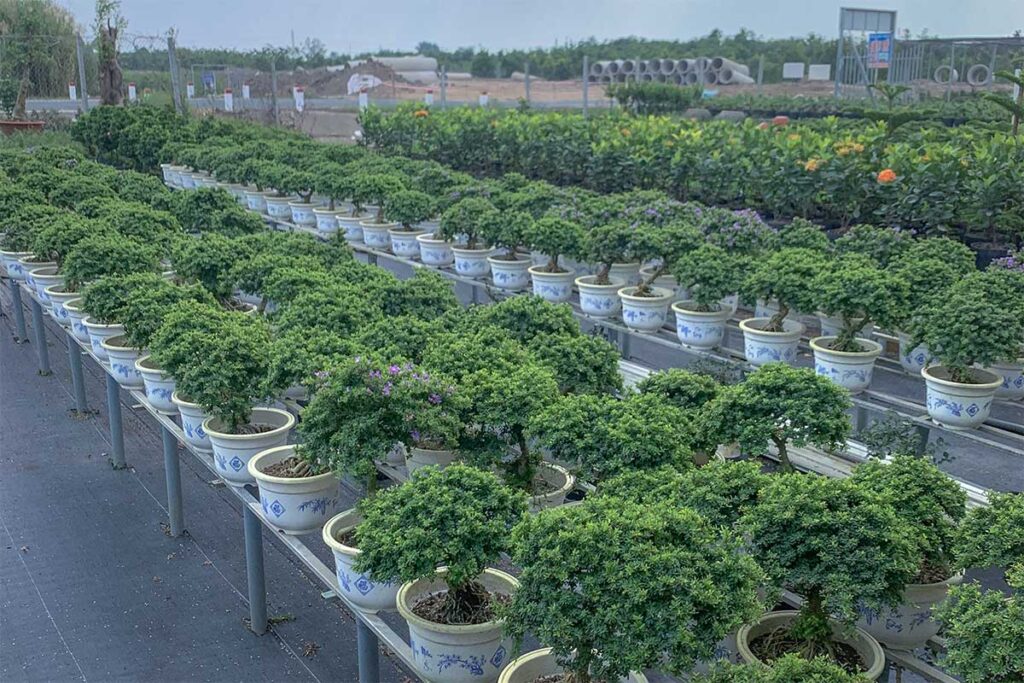
Beyond flowers, Sa Dec is known for bonsai and ornamental trees, some of them over a hundred years old. Local horticulturalists shape tamarind, areca, and fig trees into intricate designs that are sold for high prices. Even if you’re not a bonsai collector, it’s an interesting glimpse into the artistry and patience of the growers.
7. Seasonal Highlights
- Chrysanthemum fields – at their peak in the weeks before Tet, covering gardens in gold.
- Date Palm Garden – open during fruiting season for photos and fruit tasting.
- Upside-down House and similar attractions – modern, quirky photo spots, more novelty than heritage.
8. Food & Local Specialties
Sa Dec is also known for food. Don’t miss hủ tiếu Sa Đéc (Sa Dec noodle soup), sold in many small restaurants, along with local Mekong dishes like crab hotpot or grilled snakehead fish wrapped in lotus leaves. As souvenirs, you’ll find Lai Vung tangerines, pink lotus wine, Sa Giang shrimp crackers, and fermented pork rolls (nem Lai Vung) in the markets.
Practical visiting information & Tips
Entrance Fees & Opening Hours
You don’t need to pay to walk or cycle through the village streets themselves. However, many gardens and attractions charge small entrance fees, usually between 20,000–60,000 VND per person depending on what’s included (photo spots, homestay gardens, tourist complexes). Most places are open from dawn to dusk, though expect some flexibility in smaller family-run gardens.
Duration & Crowd Levels
A half-day visit is usually enough to see the main sights, walk along Sa Nhien–Cai Dao Flower Street, stop at a few gardens, and enjoy a meal. If you stay in a homestay, you’ll naturally spend longer and get a more immersive feel for local life. Crowds vary a lot by season: in the weeks before Tet, the village gets extremely busy, especially on weekends, while the rest of the year it’s fairly quiet.
Photography tips
The best light for photos is in the morning or late afternoon, when the sun is softer and the colors are warmer. During Tet, expect to share the most photogenic spots with large numbers of domestic tourists. Drones are sometimes restricted, especially in crowded areas, so don’t rely on being able to fly one.
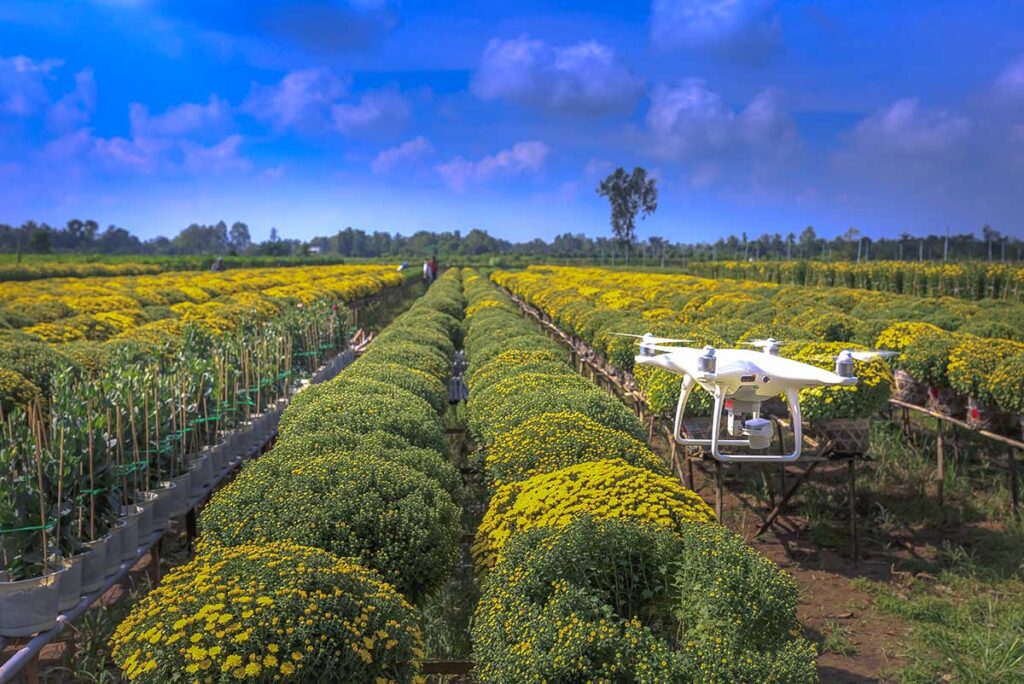
Etiquette & Responsible tourism
It can be tempting to step into the flower beds for photos, but this damages the plants and is frowned upon. Don’t pick or touch flowers without permission. If you want to support the community, buy a drink at one of the local cafes or stay in a homestay rather than asking for free access to private gardens. As with anywhere in rural Vietnam, a friendly smile and respect for local culture go a long way.
Nearby attractions
If you’re already in Sa Dec, it’s worth combining the flower village with other nearby sights:
- Huynh Thuy Le Ancient House – a colonial-era home tied to the love story of writer Marguerite Duras.
- Xeo Quyt Relic Area – a mix of forest and wartime history, accessible by sampan.
- Tram Chim National Park – one of the Mekong Delta’s best birdwatching sites (seasonal).
- Lotus fields in Thap Muoi – vast pink lotus ponds, especially beautiful in summer.
Is Sa Dec Flower Village worth visiting?
Whether Sa Dec Flower Village is worth your time really depends on when you visit. In the weeks leading up to Tet (late January–early February), the village is at its absolute best: colorful, festive, and buzzing with activity. This is when you’ll find the iconic flower displays, crowds of shoppers, and some of the best photo opportunities in the Mekong Delta.
Outside Tet, Sa Dec is still interesting, but the experience shifts. You’ll see year-round cultivation, bonsai, and roses, but not the mass displays that make the village famous. It’s more about appreciating the agricultural lifestyle than being wowed by endless blooms.
For most travelers, Sa Dec works best as part of a wider Mekong Delta trip that includes nearby destinations like Vinh Long, Can Tho, or other parts of Dong Thap. It adds variety and cultural depth, but it’s usually not worth making a long detour from Ho Chi Minh City if you’re visiting out of season.
